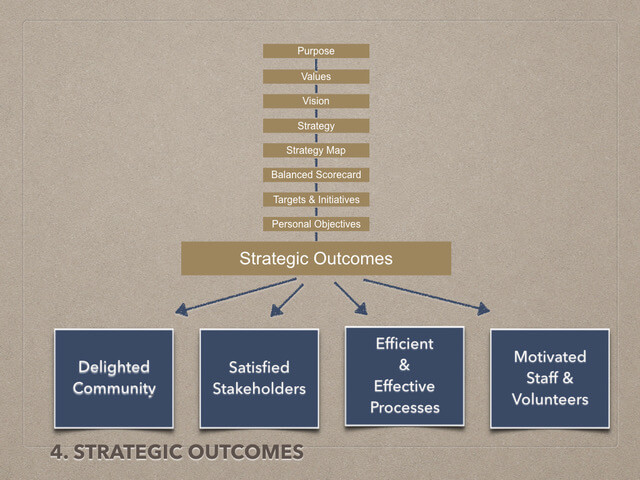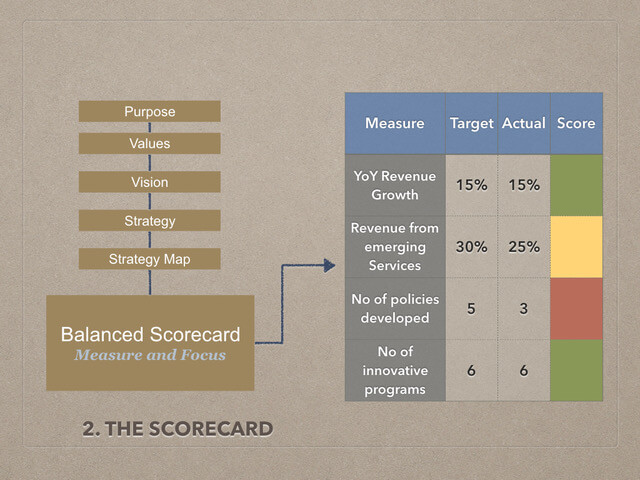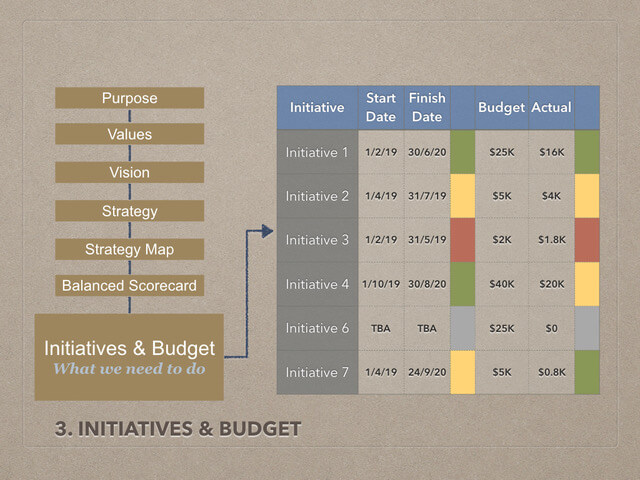governance
An Effective Strategy Execution Framework
Published: August 20, 2019
Read Time: 4 minutes

Realise your not-for-profit organisation’s vision in a simple yet effective way.
Not-for-profit organisations generally have a strong sense of purpose. They passionately can put into words why they exist, what is important and what the future state of a better world will look like. However, many Not-for-profits struggle to articulate how they will achieve their vision.
Development and execution of strategy is often seen as a complex, time-consuming and costly process, or there may be confusion regarding what strategy actually is.
Strategy development and execution does not have to be complicated. All that is needed to focus an organisation on achieving its vision is a simple yet powerful strategy framework that explains an organisation’s strategic journey in a succinct three-page document. There are two key elements to this framework: first, to develop and articulate the strategy, and second, to implement the strategy and monitor progress towards the strategic objectives.
Another key aspect of this framework is ownership. The organisation’s board owns the strategy, leads the strategy development process and is accountable for successful execution. Management has the mandate to execute the strategy and make it an integral part of business. Preferably, all staff, volunteers and interested stakeholders should participate in the development process. This will create an understanding across the entire organisation of the strategy. It will also facilitate acceptance of personal ownership by recognising the effect an individual may have on realising strategic outcomes.

The strategy framework introduced here is based on the Balanced Scorecard principles. It tells the story of the strategy, starting with the long-running objectives and linking those to a number of key initiatives that must be undertaken to deliver the desired strategic outcomes. This framework enables the organisation to monitor and adjust the implementation of the strategy. The strategy is simply the game plan for achieving the organisational vision. The strategy document developed using this framework is the manifestation of thoughtful strategy development.
The strategy framework consists of three components:
1. The Strategy Map
This map translates the strategy in a pictorial format.
The map depicts the strategic objectives and their interrelationships across four organisational perspectives. Typically, the Strategy Map outlines a three to five year horizon and does not change substantially during that duration.

The four organisational perspectives mentioned above include:
- The Learning and Growth Perspective, which explores how the organisation must learn and improve to achieve the vision.
- The Internal Processes Perspective, which asks what processes the organisation must excel at to satisfy the organisation’s community.
- The Community Perspective examines what the organisation must look and feel like to their community.
- The Profit for Purpose Perspective explains how the organisation will look to its stakeholders when success is achieved.
2. The Balanced Scorecard
The Balanced Scorecard provides the tool that links the organisation’s vision and strategy to a set of performance measures that are monitored and reported on in a traffic light format.

The Balanced Scorecard provides a short and long-term horizon. First, the scorecard quantifies the long-term measures for the outcomes the organisation ultimately wishes to achieve. Then it defines short-term milestones for the next six to twelve months. Thus, the strategy journey is broken down into manageable intervals. As the organisation starts to use the scorecard to measure the effectiveness of key strategic initiatives, it will gain insights in regards to which measures are not working, which measures should be modified, and which new measures of strategic success have emerged that could be adopted.
3. Strategic Initiatives and Budget
Strategic Initiatives define what the organisation needs to do to achieve the strategic objectives.

There should only be a handful of Strategic Initiatives. Each initiative must have a direct impact on shifting the measures of strategic success towards the desired target and must link to the strategic objectives on the Strategy Map. The more objectives a Strategic Initiative addresses, the more impact that initiative has.
It is paramount for successful strategy implementation to realise that strategy execution requires resources, time and money. Therefore, each initiative has a start and an end date, an owner, who is accountable for the execution of the strategic initiative and a budget. Progress and expenditure must be monitored on a regular basis.
However, the best documented strategy is worthless if it doesn’t become an integral part of business. An organisation genuinely lives and breathes its strategy when every organisational decision holds true against its strategy and its values. If one or the other is missing the decision most likely is not the best that could have been made.
Share this Article
Recommended Reading
Recommended Viewing
Author
-
Managing Director
- About
-
In a career spanning 20+ years, Dagmar has gained considerable experience in transforming and growing complex businesses across diverse corporate, operational and entrepreneurial roles in Australia, Asia and Europe.
She has worked with major national and multinational entities to drive critical market success by providing strategic direction, visionary leadership and innovative thinking.
Dagmar started out as a project engineer in the German petrochemical industry prior to coming to Australia in 1991 on an eight months assignment. She immigrated permanently to Australia in 1992 but spent the following years mostly overseas commissioning oil and gas plants in Asia and Europe.
Since then, she held senior executive positions with companies across a range of industries, including construction, manufacturing and engineering as well as the Not-For-Profit sectors.
In addition to her executive career, Dagmar holds a portfolio of Non-Executive Director / Board roles in a range of organisations including both, ASX listed and Not-For-Profit. She is currently the Chairman of Advanced Braking Technology. She is a Director of Amazing Days and the Jervis Bay Marine Discovery and Research Centre, and she is the Chair of the Audit, Finance and Risk Committee of Camerata – Queensland’s Chamber Orchestra.
Dagmar holds a Master of Mechanical Engineering with Rhineland Westfalia Technical University, Aachen in Germany, a Master of Business Administration with Deakin University and is a Graduate Member of the Australian Institute of Company Directors.
Found this article useful or informative?
Join 5,000+ not-for-profit & for-purpose directors receiving the latest insights on governance and leadership.
Receive a free e-book on improving your board decisions when you subscribe.
Unsubscribe anytime. We care about your privacy - read our Privacy Policy .










